Coastal Starlight
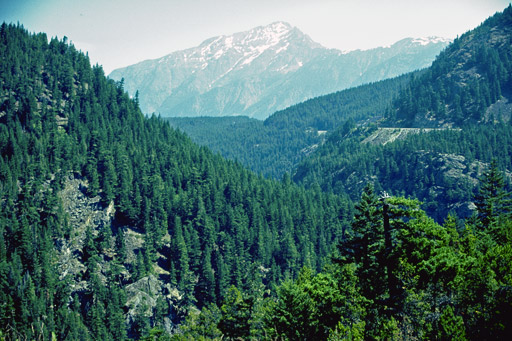
| Route 66 | Cities | Beaches |
|
Coastal Starlight |
 |
Sunset Limited |
Palmetto |
Crescent |
VIA |
Travellers from back East tend to take the Empire Builder, Chief, Zephyr or Eagle west, spend several days or a week, then take the same train east again. They rarely ride the Coastal Starlight. It doesn't cross any major mountain ranges and is rarely promoted in tourist brochures or websites. So most nonlocals assume the Starlight runs down along the seashore, offering lots of nice beach views but little else. West Coast residents know better. They ride the Starlight all the time, up to Portland or Seattle, up to Crater Lake National Park, down to San Francisco or Disneyland. They know it rivals any of the others in variety and in spectacular scenery. The Coastal Starlight runs from Seattle to Los Angeles. It departs from Seattle at 10 a.m., arrives at Los Angeles at 9 pm the following night, and via the Surfliner connecting train arrives at Anaheim (Disneyland) at 10. |
 |
.jpg) |
The stations at the two ends, Seattle and Anaheim, are among the nation's most beautiful. Seattle's (photo, left) is a century old but was recently restored and is bright, modern and spacious. It serves Amtrak, the local mass transit, Greyhound buses, and the increasing fleet of Uber vehicles. There are no indoor concessions but food trucks park just outside and serve everything from breakfast tacos to fish sandwiches. Meals on board use the same menu as the other long distance trains and the coaches, sleeping cars and diner are the same as those on other trains. The Starlight always had a Parlor Car, but it was discontinued in 2018. |
The Starlight's first 18 hours are through extremely rugged country. It traverses the Cascade Mountains, which except for a few towns are all dense forest. No Cascade peak rivals any Rocky Mountain peaks in size, but the terrain is steep and relentless (see top photo). Deep snow and ice, high drifts, powerful winds, avalanches, rock slides, downed trees and forest fires all delay or stop the Starlight. Sometimes the route is entirely shut down for weeks at a time and Amtrak has to bus passengers around the problem area, or send rescue trains after them. The Starlight is a long train, with four sleepers, four coaches, a baggage car, dining car, observation car and dorm car (for staff). It links 12 major colleges, sometimes cruising right along one edge of their campuses. It's hard to get reservations. Call several weeks ahead. |
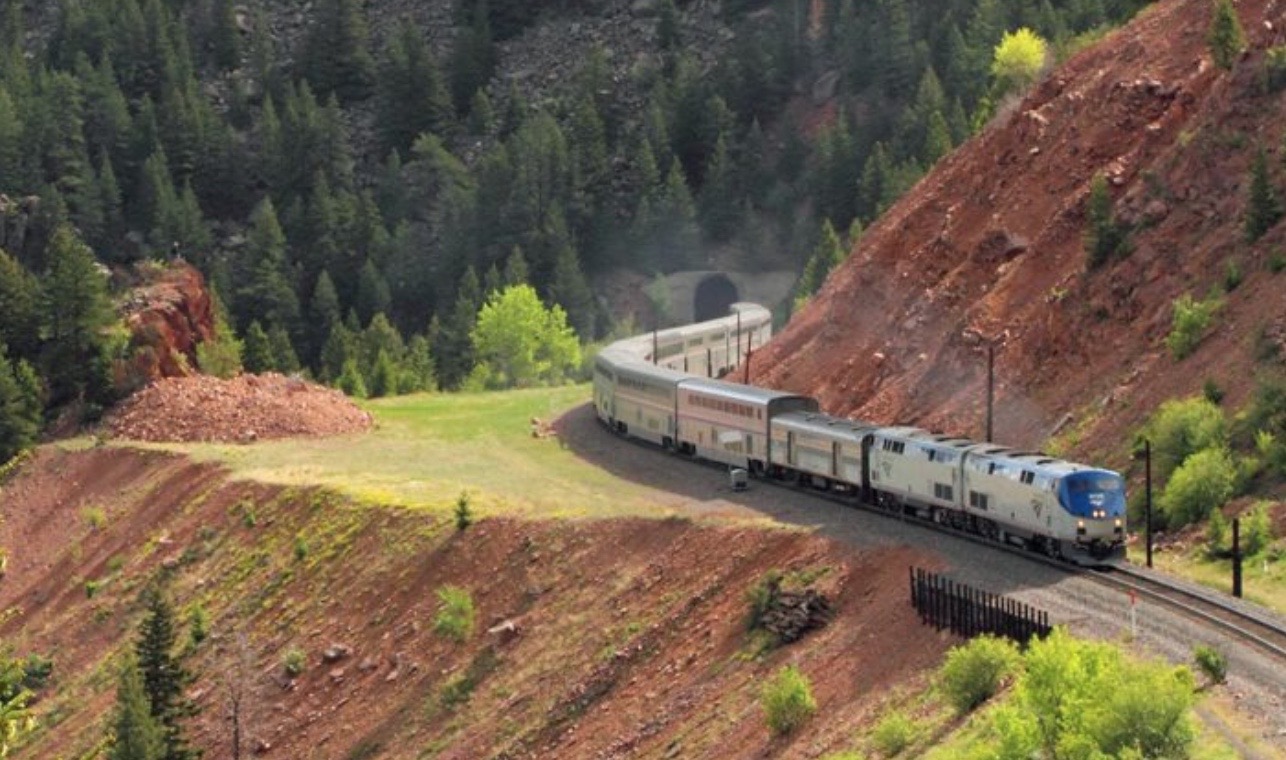 |
 |
The Starlight doesn't have anything to match the seven mile tunnel of the Empire Builder, but it has the most tunnels of any Amtrak train. The single track here occupies a very narrow right of way, and in many places tree branches brush the train windows. There are very long and steep uphills, and very tight turns, often several in a row. So the northern half of the trip takes a while. Riders get a very good view of two huge issues in modern forest management. The first is clear cutting. You'll see huge patches of forest cut to the ground and left. They will regrow, but it takes 50 years. Environmentalists oppose this practice, arguing that it leads to erosion, destroys animal habitat, and destroys the diversity that makes these forests unique (trees will grow back, but with two or three kinds rather than the dozen different kinds that grew here naturally). You'll notice a huge amount of dead wood laying on the forest floor. This has built up over two or three decades and is a major fire hazard. This dead wood is why a simple lightning strike, rather than simply burn out, builds into a major crown fire (a fire that reaches the tops of trees and destroys the trees) and may last for days or weeks. Environmentalists would rather timber companies bring in minidozers and remove that dead wood, rather than clear cutting whole mountainsides. However, timber companies are in the lumber business. They need live, tall, straight, healthy trees which produce perfect logs. And clear cutting is very efficient, whereas sending in two dozen small minidozers is very expensive. The other issue is the insect infestation which is destroying thousands of trees. You'll notice large stands of dead or dying trees. Those are the result of insects. Professional foresters have slowed the spread of these insects, but have not been able to stop or eradicate them. |
| Crater Lake is one of the most beautiful national parks and the Coastal Starlight skirts the eastern edge of it. The stop is at Klamath Falls. A shuttle goes from the train station to Crater Lake Lodge. You need to make reservations at least a month ahead because the lodge is the only lodging available within the park. It's only open during the Summer due to deep snow during the very long Winter. There's no swimming --- the water is ice cold --- but there's magnificent hiking and backpacking. If you want a place to escape the heat and humidity in mid Summer, this is it. Days are t shirt warm but nights require jackets or sweaters. The lodge includes a good restaurant serving three meals a day. | 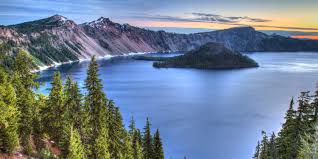 |
 |
You'll go to sleep still in deep forest. You'll wake up in a different world, the Wyoming looking landscape of California's northern Central Valley. This is actually several valleys : the Napa (which the Starlight skirts but does not enter), the San Joaquin and the Salinas. In fact, Hollywood has shot dozens of Western movies and TV series out here, since it closely resembles the landscapes of Montana, Wyoming, Colorado and Texas. In this northern region of the Central Valley they receive less rain, so cannot raise fruits and vegetables. Instead, they raise cattle. You'll see herds of them, mostly Black Angus. You'll also see occasional loading docks that allow ranchers to load their cattle onto cattle cars to ship to market. You may also see Sheep, Llamas and Horses grazing out here. The lack of trees is due to lack of water. As you head south, watch for trees to begin, first occasionally, then in ribbons following streams, then in large rows of clusters. When trees begin appearing in groups, there is enough water for fruits. |
You'll see grapevines appearing. But these are not for wine. Those would be over the hills in the Napa Valley. These are for raisins. 2,000 farmers on 200,000 acres produce the finest raisins in the world here. They used to pick the grapes, artificially aging them with gas ovens. Now they allow the grapes to shrivel and die on the vine, which preserves more of the taste and retains more of the iron. The Joaquin Valley used to produce almost all of the world's raisins. Now China, India, Turkey and Iran have become serious competitors, and the Joaquin Valley is down to only 40% of the world supply. However, it is unanimously agreed that these are still the best raisins in the world. 90% of the grapes you'll see here are Thompson Seedless. Once the raisins have dried on the vine, they are picked and taken to processing barns, where the stems are removed and the raisins are washed, dried and boxed. Government inspectors than sample the middle of each box to see if the quality is acceptable. Raisins are unique in that they retain 100% of their vitamins when dry. |
 |
 |
As you continue southward, you'll come into Lettuce country. 71% of the Lettuce grown in the U.S. is grown here in the San Joaquin Valley, with the rest being grown in other California and Arizona locations. Last year in this one valley 4500 growers on 250,000 acres produced 400,000 tons of Lettuce, worth $1.5 billion, and representing 40% of the world total. The Lettuce grown here is of two kinds : Head Lettuce and Leaf Lettuce. The Leaf Lettuce is almost all Romaine. The Romaine scares which occur periodically are due to irrigation. Cattle contaminate streams, which flow into the Lettuce farms and have their water drawn up by pumps and sprayed over the crops. Lettuce harvesting is labor intensive and relies on migrant workers. Many if not most of them are from Mexico and Latin America. Traditionally they have come north for the planting and harvest seasons, stayed around to work other crops, then returned home during the off season. Problems at the border have tightened security, making this flow more difficult, and Lettuce farmers are having trouble getting their crops picked. |
| Between the mountains and the agriculture rich valleys, there is great beauty on this trip. Unfortunately, there's sadness, too. Out your window, you'll see one homeless camp after another. These rows of tents line the railroad tracks, often under highway bridges but sometimes out in the open. They are a result of open borders, which have allowed over a million illegal immigrants to flood into California. The state simply cannot build low income housing fast enough to house all these people. But the obscenely high cost of housing in California has displaced even U.S. citizens. And the idea of releasing thousands of mentally ill from institutions, and thousands more from prisons, has created a population of low income, unskilled and unattached people. The Salvation Army and other charities have raised the money to provide tents and sleeping bags to at least keep the homeless dry and warm, but no one has a solution for the problem. | 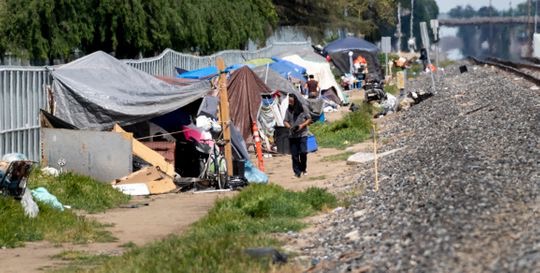 |
|
Grapes and Lettuce aren't the only crops you'll see. The valleys produce a long list of fruits and vegetables, including Almonds. And there's a new crop : Cannabis, or Hemp. Whether intended for medicinal uses or fabric, this is the state's fastest growing crop. If you're sitting at an East facing window, you'll pass the James Dean Cannabis Farm, the East of Eden Cannabis Farm and the Clear Creek Cannabis Farm. You'll also pass several parks, town squares and other sites named after Jack London and John Steinbeck, the Salinas Valley's two literary giants. While Grapes of Wrath, East of Eden and The Call of the Wild are their three most famous novels, they wrote many more, most of which are set here. All these fruits and vegetables require pollination. Since the valley cannot support enough bees year round to do that pollinating, beekeepers from around the nation actually rent their beehives to San Joaquin and Salinas Valley farmers for the flowering seasons. You'll pass huge clusters of bee hives, some on truck beds, some local, as seen here at left. |
The climb out of the Salinas Valley is one of the trip's most scenic legs. This is the Santa Lucia Range. These mountains doin't have the height of the Cascades or the Rockies, but they're rugged. Again the trackage becomes steep and winding. If both trains are on time, sometime during this crossing the Coastal Starlight heading north will pass going the other direction, requiring that our southbound train pull onto a siding and wait. We'll pass through seven tunnels here and you'll enjoy vast panoramic views. Building this railroad was an epic achievement back in the late 1800s. These mountains separate the Salinas Valley from the Pacific Coast. The clouds deposit their rain on the western slopes, leaving the Salinas Valley much drier, as you have seen. Again cattle will be seen grazing on the steep grassy mountain slopes. |
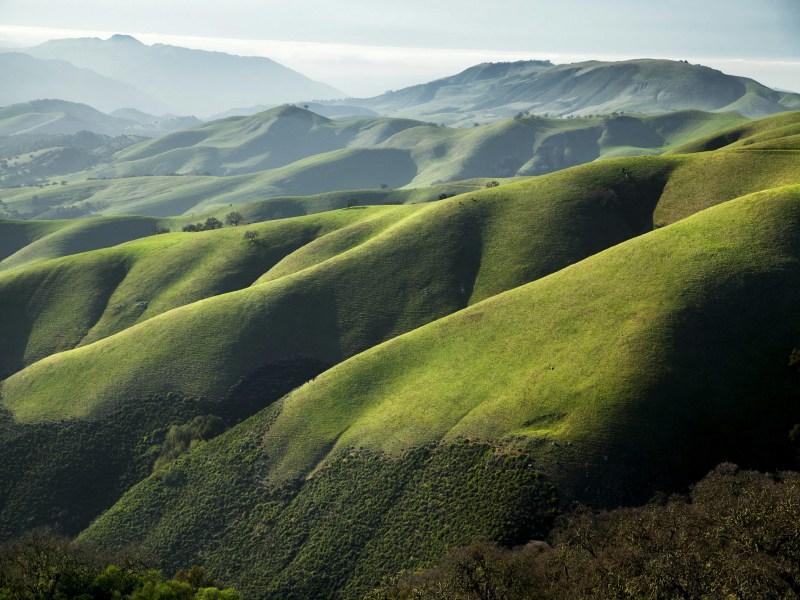 |
 |
Then we descend to the coastline. From here on until downtown Los Angeles, we follow the water. If you brought a good pair of bincoculars, this is the place to use them. Out in the water you can spot whales, seals, porpoises, sea turtles, sea otters and other ocean life. The beaches here are mostly empty. The train is passing through Vandenberg Air Force Base and no public roads cross the base. Occasionally a few adventurers with good off road vehicles can be found swimming or surfing. They followed the coastline up from Santa Barbara, totally offroad. However, the landscape is interesting, with rocky outcroppings, terraces, cliffs and wide beaches. You'll see spectacular sunsets. A filter should allow you to get good photos. Despite California's reputation as a surfing center, often the water along here will be quite calm, not even active enough to bob up and down in an inner tube. The famous surfing beaches are further south. |
The climate has changed, You're now seeing palm trees and desert plants. The architecture has changed, too. Railroad stations like the one at right display a Spanish/Mexican influence, with wide porches, thick walls, smaller windows and tile roofs. The goal is to keep cool. In Spring and Fall temperatures along here will be in the 70s, but in Summer they'll be 100 or close. The Los Angeles Union Station is another huge transportation center, with other trains, local transit and buses constantly coming and going. Your train unloads underground and much of the station is also under ground. The station is probably the nation's most poorly signed. There is a Metropolitan Lounge with free snacks, comfortable chairs and a private entrance to the loading platforms. The Surfliner, Southwest Chief, Texas Eagle and other Amtrak trains depart from here. If you're visiting somewhere in L.A., calling an Uber is probably your best strategy. |
 |
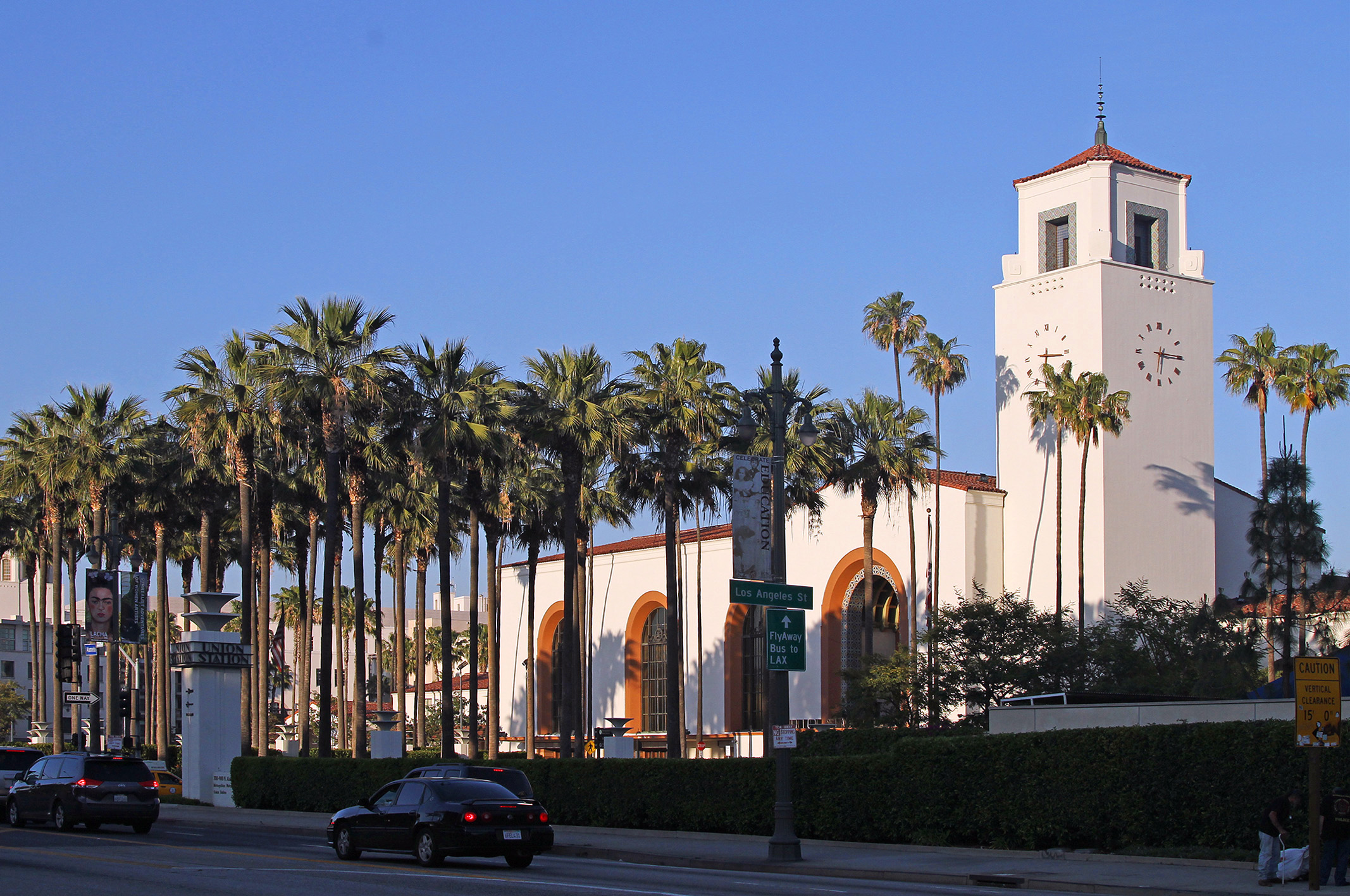 |
The Los Angeles Union Station is beautiful outside and parts of it are beautiful inside. But it is a huge transportation center, with other trains, local transit, and buses constantly coming and going. The Coastal Starlight unloads underground and much of the station is underground. The station is probably the nation's most poorly signed and there are no guards or agents to help with directions. If you're visiting or staying somewhere in L.A., your best bet is to call an Uber. If you're catching the Texas Eagle or Southwest Chief, you'll likely be overnighting here, since they probably left an hour before we arrived. In that case, your best bet is to walk over to the loading dock for the Surfliner and take it 30 minutes out to Anaheim. You can spend the day at Disneyland, catch the 5 pm Surfliner back to Union Station, and catch the Eagle or Chief the following evening. When you arrive back at Union Station, you'll want to find your way to the Metropolitan Lounge, a nicely furnished Amtrak waiting room for sleeping compartment passengers. The trains load just outside the door. / |
It's worth going to Disneyland by Amtrak just to see the Anaheim station. This $68 million state of the art terminal is not only the most beautiful Amtrak station in the country, but was named America's Most Beautiful Building Of Any Kind in 2015. Last year the 120 feet high structure hosted 287,415 Amtrak passengers, plus thousands more riding Metro rail, Greyhound Bus and Uber. The station fits right in with Disney's monorail and Anaheim's cutting edge 21st Century vibe. The city will host a Summer Olympics and this building will be the western terminus of the L.A.-Las Vegas maglev high speed train. A phone call summons an Uber driver, who can whisk you two miles to either a Disney Resort Hotel or one of the independent hotels facing the entrance. We recommend the Holiday Inn Express. It's one block from the entrance, is a new hotel, and offers various special rates. |
 |
|
|||
|